Culture of Latvia
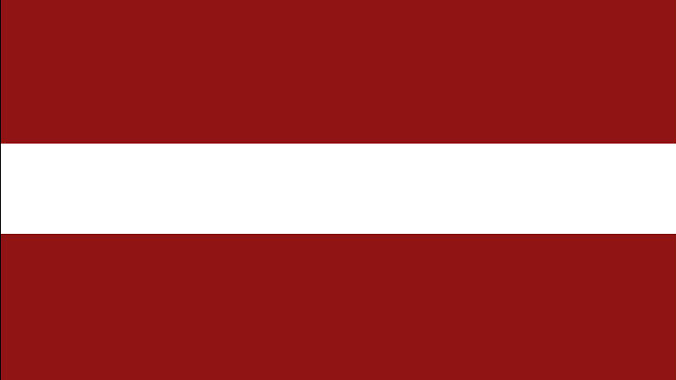
Culture Name
Latvian
Alternative Names
Latvija, Latviešu Kultūra, Lettiņi (German; when Latvians use this to refer to themselves, it is always in a tone of caricature or self-depreciation)
Orientation
Identification. Baltic tribes arrived in what is now Latvia from the Pripet marshes around 1000 B.C.E. These included the Lettgalians, and the term Latvju derives from the peoples and province of Latgale . The most important minority group was the Baltic Germans, who settled there in the thirteenth century. Jews arrived in the seventeenth century. A sizable Russian community moved to the cities, particularly Riga. The polarization of cultural identification in terms of Latvian and Russian is primarily a rural-urban divide.
Location and Geography. Latvia lies on the eastern shores of the Baltic sea, with an area of some 25,100 square miles (65,000 square kilometers). The capital, Rīga, lies at the mouth of the Daugava River. Latvian lands form an extension of the great plains of Russia. Latvia's importance as a mediator between east and west was recognized in 1710, when the capture of Rīga afforded the tsar Peter the Great "a window on the west."
Demography. Urbanization, war, and the Soviet occupation have been the major sources of demographic change. Until the Soviet occupation Latvia was a predominantly rural society. World War II and Soviet occupation brought about massive changes. The German occupation resulted in the extermination of the Jewish population as well as thousands of Latvians. The Soviet occupation led to the loss of 250,000 Latvians through exile and death. At present ethnic Latvians account for 56 percent of the population.
Linguistic Affiliation. Latvian belongs to the Baltic group of languages. Livonian, a Finno-Ugric language is now almost extinct but is experiencing a revival. By the twelfth century a common language was spoken. Russian has had a strong influence on religious vocabulary, while German has influenced the domestic vocabulary.
Written Latvian bore little relationship to the spoken language until 1638. Spelling followed German orthographic traditions until the foundation of an independent state. Russian linguistic influence is also noticeable.
In the nineteenth century most educated Latvians spoke German. In the second half of the nineteenth and the early twentieth centuries the educated segments of the population became fluent in Russian. During the Soviet period Russian was a compulsory subject at school. In the post-independence period parents can have their children educated in Latvian or Russian.
Symbolism. Folk songs ( dainas ) are the most potent symbol of national identity. These songs construct a vision in which the natural, human, and supernatural worlds are intertwined. Oak and lime trees symbolize men and women. The apple tree is frequently associated with orphanhood, a state that symbolically represents the Latvian nation.
The rural character of the national identity was promoted by the role of landscape in art and literature. An association of Latvian artists founded in 1929 argued "for art with a Latvian content and form," primarily in landscape painting. The result of this cultural policy was to include not only the recently emerged intellegentsia and middle classes but also those who lived in the countryside and worked the land.
The repression of the Soviet period contributed symbols of national identity and introduced new
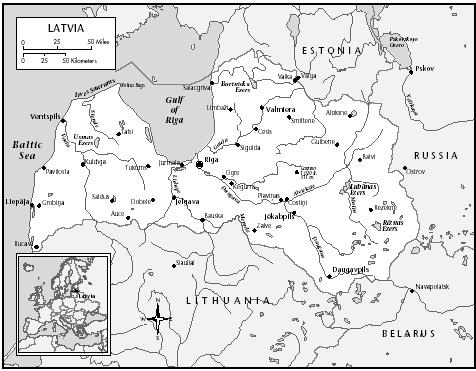
Latvia
days of commemoration and mourning in the national calendar.
History and Ethnic Relations
Emergence of the Nation. The abolition of serfdom in the Baltic provinces between 1817 and 1861 and the removal of restrictions on residence in 1863 opened up opportunities for travel and education. The second half of the nineteenth century saw an enormous increase in Latvian publications, many of them dealing with nationality issues. The revolutions of 1905 and 1917 channelled the disaffection of the peasantry and led eventually to the founding of the state in 1918.
National Identity. In the second half of the nineteenth century many novels and plays dealt with the hardships of serfdom and helped shape a historically rooted ethnic identity, but national identity was consolidated largely through the collection of folk songs after the 1870s. Many of those songs describe the harshness of German masters and the hardness of work. In the period of independence from 1918 to 1940, farmers were supported by government loans and the redistribution of land, the extension of free schooling, and support for the arts. The undermining of national and cultural identity was a prime goal of the Soviet occupation.
Ethnic Relations. Ethnic relations have been shaped by twentieth-century historical events. The early period of independence was characterized by a tolerance of cultural diversity. The constitution of 1922 safeguarded the rights of all citizens and protected the rights of minorities. The climate became increasingly nationalistic after 1934, and various
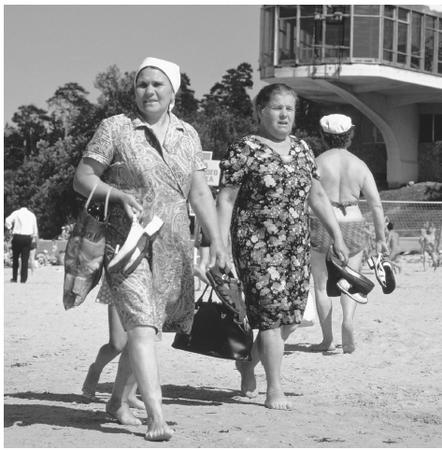
Women at Baltic Sea Beach in Jurmala, near Rīga.
government policies were introduced to promote Latvian culture.
Urbanism, Architecture, and the Use of Space
Until World War II Latvia was essentially a rural society, with two-thirds of the population living in the countryside. Centuries of serfdom contributed to the longing for one's own piece of land. In the eastern province of Latgale the dominant type of settlement was the village, but in the rest of the country separate individual farms predominated. The establishment of the Ethnographic Museum in 1922 transformed the farmstead into an art form. The farmstead consisted of a set of buildings grouped around a yard: the living dwelling faced the cowshed and the storehouse while the threshing house and steam bath house were set at a further distance. The adjoining farm buildings were often of a similar size and featured a more substantial and elaborate construction. The use of space by farmstead householders changed with the seasons. In winter the occupants would retreat to the warmth of the hearth. In summer, they would disperse to sleep in the various outbuildings.
The growth of the population of Rīga in the late nineteenth century led to a huge expansion in the building of apartment houses whose architectural style expressed the social aspirations and ethnic membership of their owners. With the growth of the urban population, summer houses became popular. Brick was the preferred medium, but wood houses were built in imitation of the rural style. The Soviet occupation after 1940 resulted in the expropriation of property and a dramatic contraction in the entitlement to space. Rural dwellings were expropriated and state-sponsored immigration from the Soviet Union led to the building of high-rise blocks to house the incoming labor force.
Food and Economy
Food in Daily Life. The staples of the diet are rye, wheat, and potatoes. Dairy products are valued for their purity and health-giving qualities. Milk, butter, sour cream, and curd cheese were traditionally highly prized additions to the diet. Pork is the most commonly eaten meat. Smoked fish are particularly popular in Rīga and the coastal areas. A huge variety of bread is available in markets and shops. During the Soviet period the main meal of the day was eaten outside the home in a canteen attached to the workplace or school. The evening meal usually was not cooked and consisted of bread and cheese or sausage and possibly salad. There has been a diversification of foods and eating habits, and pizza and Chinese food have found ready acceptance.
Food Customs at Ceremonial Occasions. Yeast breads are an essential ingredient of all family celebrations and religious festivities. Birthdays and namedays call for klingeris , a saffron-scented bread made of yeast dough with dried fruits into the shape of a figure eight and decorated with flowers. Christmas and other religious and ceremonial occasions call for home-baked pīrāgi bread parcels stuffed with bacon and onion. Beer and šnabs are drunk. A special cheese made with caraway seeds, jāņa siers , is made expressly for the midsummer solstice festival of Jāņi and drunk with specially brewed beer.
Basic Economy. Historically, the economy was dominated by transit trade and agriculture, although Rīga has been an important seaport and trading center since the Middle Ages. Many peasants lived in isolated farmsteads, but villages and strip landholdings existed in the eastern province of Latgale. Agrarian reform after World War I led to a prevalence of small family farms. During the Soviet occupation, collective and state-run farms dominated this sector, although small family farms were tolerated. Industry was concentrated in urban centers after the nineteenth century, a pattern that continued under Soviet rule.
Land Tenure and Property. Before the formation of the republic in 1918, land ownership was divided between peasant smallholders and the Baltic German nobility. The distribution of land to the peasantry after World War I was reversed under the Soviet occupation as land was collectivized and put under the control of the state.
Major Industries. In the czarist period, Rīga, Liepāja (Libau), and Ventspils (Windau) became major transit centers for trade between Russia and Western Europe. Flax, timber, hides, rye, butter, and eggs moved west in exchange for rubber, steel, and coal. Rīga became a major export and processing center for timber at that time. In the 1920s and 1930s, industry was restructured, with an orientation toward internal resources and markets. Later, rapid industrialization and ubranization caused a major shift in the economy. Since independence, there has been a decline in agriculture and heavy industry and growth in the financial and service sectors.
Social Stratification
Classes and Castes. In the nineteenth century, social mobility depended on education and the ability to speak German. The period of independence after World War I led to the formation of a middle class of professionals and businesspeople. Under the Soviet occupation, professional positions were filled primarily by Russian immigrants. Social mobility was linked to ethnicity and membership in the Community Party. Since 1990, although wages have not kept up with inflation, creating new types of poverty, education has remained the route to professional success and high social status.
Political Life
Government. Under the constitution of 1991, the highest legislative authority is vested in the parliament ( saeima ), which includes one hundred members elected in general multiparty elections every four years (before 1998, it was every three years). The parliament elects the president and prime minister.
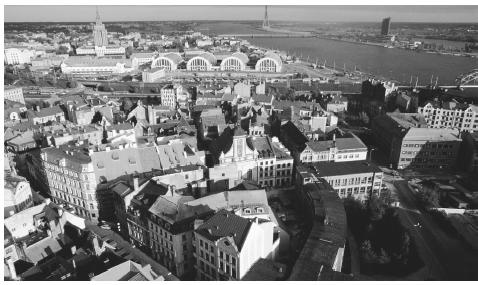
Architectural view of the old town center in Rīga.
The prime minister is responsible for forming the government, while the president has primarily nominal powers, such as nominating the prime minister, declaring war, and dissolving the parliament. The main power lies with the prime minister and the cabinet of ministers. Only the citizens of Latvia can elect members of parliament and local councils or hold elected positions.
Gender Roles and Statuses
Division of Labor by Gender. Women's employment is primarily in lower-paid occupations, such as teaching, nursing, and culture management. Although employment levels are roughly equal for men and women, men are four times more likely to be employers. Women are under represented in political and legislative institutions. In the home women spend nearly twice as much time on housework as do men. Traditionally, women have been responsible for family maintenance, and this conferred a privileged role on the male members of the household.
The Relative Status of Women and Men. Literacy rates are equivalent between women and men. Half of secondary school graduates are women, and there are more female than male university graduates. The acceptance of gender inequality in the 1990s may be a reaction to the imposed gender equality of the Soviet period. Latvian culture lacks cultural examples of female leadership and entrepreneurship. The image of woman as a caring mother and loyal and supportive wife in folk songs has led to the perception of women as occupying a secondary role in the public field and a primary role in the domestic sphere.
Marriage, Family, and Kinship
Marriage. Traditionally, marriage in the Baltic provinces was virilocal (meaning women moved away from their families to live in the husband's farmstead), and descent was traced patrilineally. The patrilineal kin group ( dzimta ) consisted of a man and his brothers and their wives and children. However, the household also contained male and female servants, shepherds, orphans, and foster children. Today, marriage is viewed as the natural outcome of emotional and sexual maturation, and a prolonged single status is stigmatizing for women. In 1998, 37 percent of children were born outside wedlock.
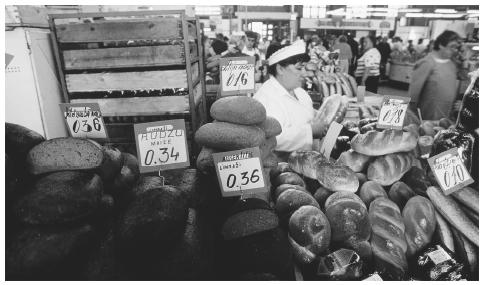
A vendor handles baked goods at a stall in the Rīga Municipal Market.
Domestic Unit. Cramped living conditions are both a reason for seeking the independence marriage promises and its consequence, as forced residence with in-laws intensifies the need for space.
Socialization
Child Rearing and Education. Gentleness in caring for infants and teaching children by example are highly valued. Traditional child-rearing practices emphasize the importance of work and respect for nature. Grandparents play an important part in child care. Until recently early retirement for women allowed grandmothers to look after young children while the mothers worked. Summers in the countryside with grandparents are highly valued.
Higher Education. Higher education traditionally provided an escape from a deeply stigmatized identity. The loss of a familiar social landscape and the financial hardship suffered by the professional classes in the post-Soviet era has led to diminished demand, if not respect, for higher education.
Etiquette
Restrained behavior, including lowered voices and the avoidance of eye contact, is expected in public places. Self-control, particularly with regard to anger, is highly valued. Until the identity of strangers is established, Latvians try to avoid acknowledging the presence of others. Relationships between same-sex friends and family members are characterized by a high degree of intimacy, body contact and the use of affectionate diminutives.
Religion
Religious Beliefs. The Christianization of Latvia occurred through contact with Germans and Russians. The Orthodox Church arrived before the twelfth century, and the Catholic religion was brought by the knights of the Teutonic order. The Moravians who arrived in Rīga in 1729 and founded a seminary in Valmiera quickly attracted a following. This movement evoked ecstatic responses and acquired a strong nationalistic streak. Baptists who arrived in the mid-nineteenth century also succeeded in awakening the interest of the indigenous population. The Lutheran and Catholic religions were identified with the oppressive Baltic German presence.
Traces of traditional earlier beliefs have been assimilated within the local understanding of Christianity, and influence everyday attitudes and conversation. The continued celebration of the midsummer solstice Jāņi is a reminder of the power of earlier beliefs and practices and has come to symbolize national identity.
Religious activity was repressed during the period of Soviet occupation, and many ministers were imprisoned. However, funerals and commemorative days of the dead were highly elaborate affairs and came to provide an indirect vehicle for the expression of national sentiment. The post-Soviet era has witnessed a revival of religious practice and the introduction of a large number of new religious movements.
Medicine and Health Care
Soviet Latvia was well provided for in terms of medical and psychiatric care. However, there was an absence of family practitioners, and this led to an extensive use of emergency ambulance services. Post-Soviet attempts to privatize health care have met with resistance. Latvia has a strong tradition of folk remedies and treatments which is undergoing a revival.
Secular Celebrations
Commemorations of the Molotov-Ribbentropl Act (23 August) and forced collectivization under Soviet rule (15 June and 25 March) are now days of national mourning.
The Arts and Humanities
Support for the Arts. During the period of independence the government generously supported visual, literary, and performance arts. Founded exactly two years after the declaration of independence, the Cultural Foundation was established in 1920 to promote and give financial support to the arts; its self-avowed rationale was closely linked to the development of national identity.
During the Soviet period, artists and writers were kept under surveillance and their work was heavily censored. This was done largely through state sponsorship. Artists who were approved by the state were given superior accommodation and the state purchased their work.
During the post-Soviet period, government support of the arts has been severely curtailed. Even the National Opera House, whose restoration has come to symbolize the reemergence of an independent cultural identity, has had difficulty securing funds from the government.
Performance Arts. The first song festival took place in 1872 and involved the coming together of local choirs from different parts of the country. These early festivals played an important role in the emergence of national identity and attracted large numbers. During the Soviet period the festivals were repressed or used as vehicles of propaganda. During the movement toward independence from the Soviet Union, folk songs again became a powerful vehicle of social criticism and national sentiment.
Bibliography
Bunkse, Edmunds Valdemars. "Landscape Symbolism in the Latvian Drive for Independence." Geografiska Notiser 4: 170–178, 1990.
Eglīte, P. and Zariņa, I.B.,eds. Time Use by Gender in Latvia , 1999.
Gimbutas, Marija. The Balts , 1963.
Grosa, Silvija. Art Nouveau Time and Space: The Baltic Countries at the Turn of the Century , 1999.
Hiden, John and P. Salmon. The Baltic Nations and Europe , 1996.
Karklins, Rasma. "Ethnic Integration and School Policies in Latvia." Nationalities Papers 26 (2): 283–302, 1998.
Kundzins, Pauls. Latvju Seta: The Latvian Farmstead , 1974.
Lieven, Anatol. The Baltic Revolution , 1993.
Plakans, Andrejs. "Peasant Farmsteads and Households in the Baltic Littoral, 1797." Comparative Studies in Society and History 17: 2–35, 1975.
——. A Historical Dictionary of Latvia , 1997.
Silins, Janis. Latvijas Maksla 1915-1940 , 1990.
Skujenieks, Margers. Atlas Statistique de la Lettonie , 1938.
Skultans, Vieda. The Testimony of Lives: Narrative and Memory in Post Soviet Latvia , 1998.
Svabe, Arveds. Agrarian History of Latvia , 1930.
Vikis-Freibergs, Vaira, ed. Linguistics and Poetics of Latvian Folk Songs , 1998.
